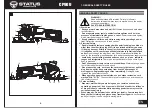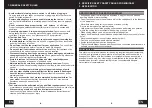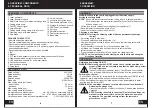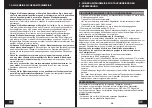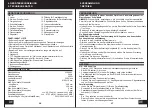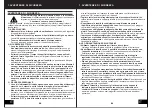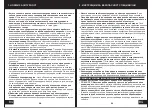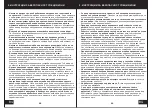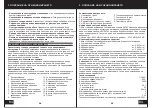
EN
4
1. GENERAL SAFETY RULES
•
Avoid accidental starting, be sure switch is off before plugging in.
Carrying tools with your finger on the switch or plugging in tools that have the
switch on invites accidents.
•
Remove adjusting keys or wrenches before turning the tool on.
A wrench
or a key that is left attached to a rotating part of the tool may result in personal
injury.
•
Do not overreach. Keep proper footing and balance at all times.
Proper footing and balance enables better control of the tool in unexpected
situations.
•
Use safety equipment. Always wear eye protection.
Dust mask non-skid
safety shoes, hard hat, or hearing protection must be used for appropriate
conditions. Ordinary eye or sun glasses are NOT eye protection.
4) Tool Use And Care
•
Use clamps or others practical way to secure and support the workpiece
to stable platform.
Holding the work by hand or against your body is unstable
and may lead to loss of control.
•
Do not force tool Use the correct tool for your application.
The correct tool
will do the job better and safer at the rate for which it is designed.
•
Do not use tool if switch does not turn it on or off
. Any tool that cannot be
controlled with the switch is dangerous and must be repaired.
•
Disconnect the plug from the power source before making any adjustment,
changing accessories, or storing the tool.
Such preventive safety measures
reduce the risk of starting the tool accidentally.
•
Store idle tools out of reach of children and other untrained persons.
Tools are dangerous in the hands of untrained users.
•
Maintain tools with care, keep cutting tools sharp and clean.
Properly
maintained tools with sharp cutting edges are less likely to bind and are easier to
control.
•
Check for misalignment or binding of moving parts breakage of parts
and any other condition that may affect the tools operation. If damaged,
have the tool serviced before using.
Many accidents are caused by poorly
maintained tools.
•
Use only accessories that are recommended by the manufacturer for
your model.
Accessories that may be suitable for one tool, may become
hazardous when used on another tool.
5) Service
•
Tool service must be performed only by qualified repair personnel.
Service
or maintenance performed by unqualified personnel could result in a risk of injury.
•
When servicing a tools use only identical replacement parts.
Use of unauthorized parts or failure to follow maintenance instructions may
create a risk of electric shock or injury.
5
EN
2. SPECIFIC SAFETY SAFETY RULES FOR MINI SAW
3. APPLICATION
SPECIFIC SAFETY RULES FOR MINI SAW
APPLICATION
• Keep hands away from cutting area and blade. Keep your second hand on
auxiliary handle or motor housing.
• Do not reach underneath the workpiece. Adjust the cutting depth to the thickness
of the workpiece.
• Never hold piece being cut in your hands or across your leg.
Secure the workpiece to a stable platform.
• Hold power tool by insulated gripping surfaces when performing an operation
where the cutting tool may contact hidden wiring or its own cord.
• When ripping always use a rip fence or straight edge guide.
• Always use blades with correct size and shape (diamond versus round) of arbor
holes.
• Never use damaged or incorrect blade washers or bolt.
• Don't use any abrasive wheels with this machine!
• Avoid overheating the blade tips during use!
• This tool should always be used with the dust hose connected and attached to a
suitable vacuum cleaner/dust extractor.
This machine is primarily intended for the sawing, longitudinally and transversely,
of solid wood, chipboard, plywood, plastic, aluminum, tiles and stone held in a
fixed position. Please note that the blade pre-installed in the saw as supplied is
intended for wood only. Any other usage or modification to the device shall be
considered as incorrect use and could give rise to considerable dangers.
Not suitable for commercial use


